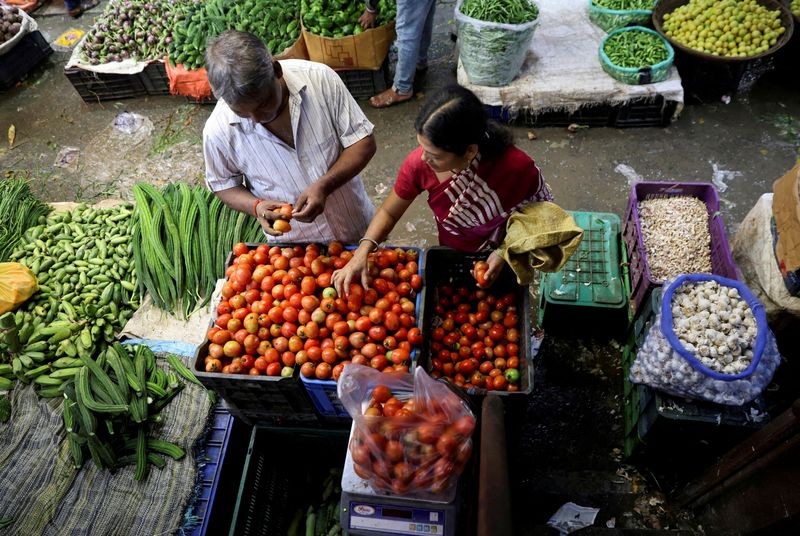By Anant Chandak and Rahul Trivedi
BENGALURU (Reuters) -Consumer price inflation in India climbed to a 14-month high of 5.81% in October primarily due to a spike in vegetable and edible oil prices, a Reuters poll of economists predicted, a shade below the central bank’s tolerance threshold of 6.0%.
Food prices, which make up nearly half of the inflation basket, likely increased at a faster pace last month. Tomatoes, a key ingredient in every Indian kitchen, are expected to have surged by double digits in price as uneven rains disrupted production.
The government’s decision to raise import taxes on edible oils by 20 percentage points in mid-September also likely helped to drive prices up faster, further straining household budgets.
Annual retail inflation as measured by the consumer price index (CPI) likely rose a second straight month to 5.81% in October, the highest since August 2023, according to the median forecast from a Nov. 4-8 Reuters poll of 52 economists. It rose to 5.49% in September, higher than forecast.
Estimates for the data, set to be released on Nov. 12 at 1030 GMT, ranged from 5.00% to 6.30%, with nearly a third predicting inflation to hit 6.00% – the upper boundary of the RBI’s 2%-6% target range – or above.
“There is broad-based price pressure with a pronounced increase visible in tomatoes and edible oil. For the former, lower arrivals were primarily due to a lagged impact of unseasonal rains observed in September. For edible oils, a sharp increase is visible because of imported inflation,” Dipanwita Mazumdar, economist at Bank of Baroda (NS:BOB), said.
“Going forward, rising intensity of climate risks, weaker currency against a stronger dollar and geopolitical risks might pose further upside risks to inflation,” she said.
The rupee fell to its weakest ever on Thursday following Donald Trump’s victory in the U.S. presidential election. An overall strong dollar, with downward pressure on the rupee, may be one constraint preventing inflation from softening quickly.
Core inflation, which excludes volatile items such as food and energy and is seen as a better gauge of domestic demand, was forecast to be 3.60% in October, according to the median estimate from a smaller sample of 21 surveyed.
“Core would also be on the upside due to frontloading of festive demand and higher gold prices,” Mazumdar said.
The Indian statistics agency does not publish core inflation data. Economists estimated it at 3.50% in September.
Reserve Bank of India (NS:BOI) Governor Shaktikanta Das on Wednesday highlighted the upside risks to inflation, dampening immediate expectations for a rate cut. A slim majority in a separate Reuters poll expected the RBI to cut its key repo rate by 25 basis points to 6.25% in December.
However, with inflation not expected to return to the 4% medium-term target until at least 2026, economists in the poll cautioned that rate cut could be delayed until early next year.
“I don’t think it’s cast in stone what the rate cut cycle should look like … If you look at RBI’s forecast of growth, there is very little reason why support to growth is needed,” said Suvodeep Rakshit, senior economist at Kotak Institutional Equities.
The RBI predicts economic growth of 7.2% economic growth this fiscal year, which some economists consider to be optimistic.
Separately, wholesale price index-based inflation is expected to have surged to an annual 2.20% last month from 1.84% in September, the survey showed.

